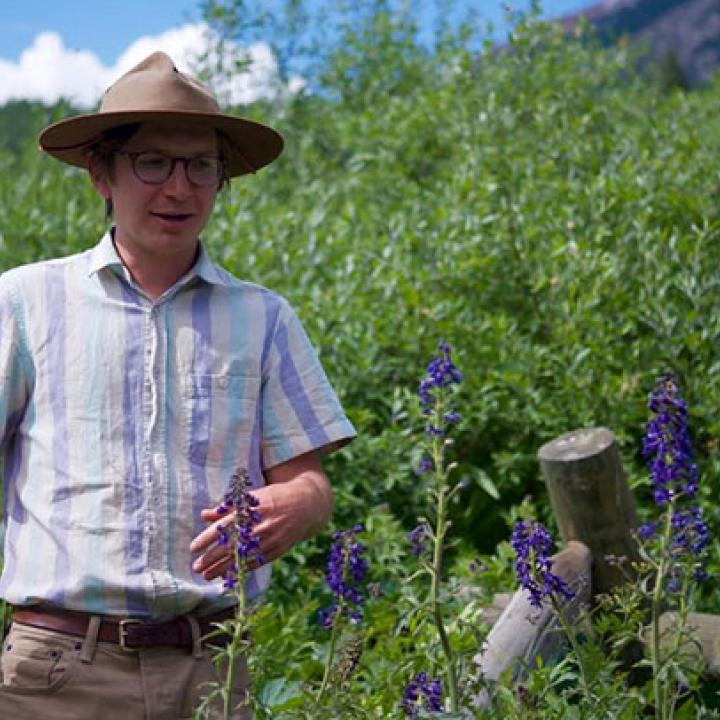
- Professor of Instruction, Plant Biology and Conservation, Northwestern University
- Graduate School Faculty, Plant Biology and Conservation, Northwestern University
- Principal Investigator, The Rocky Mountain Biological Laboratory, Gothic, CO
- Ecological Society of America
- Population & community ecology
- Importance of species interactions
- Ecological networks
- Plant-pollinator interactions
- Temporal ecology and phenology
- Ecology of climate change
- Pollinator declines
Research in the CaraDonna Lab investigates the interplay among species interactions, population dynamics, and community patterns. We use the mutualistic interactions among plants and pollinators as a model system to ask fundamental ecological questions about the importance of species interactions and to understand the ecological consequences of global change (e.g., climate change, biodiversity loss, pollinator declines, urbanization). We are also particularly interested in temporal ecology and the flexibility of species interactions. We address research questions using a variety of approaches including: observational field studies that leverage existing natural variation; field and laboratory experiments that build upon knowledge of this natural variation; analysis of long-term datasets and natural history collections; and quantitative tools like network analysis and simulation models. We also very much value basic natural history and we love working as a collaborative team. These days, most of our research takes place in the Colorado Rocky Mountains at the Rocky Mountain Biological Laboratory and also within The City of Chicago.
A handful of selected publications!
The shifting importance of abiotic and biotic factors across the life cycles of wild pollinators. 2022. Ogilvie, J.E. and P.J. CaraDonna. Journal of Animal Ecology https://doi.org/10.1111/1365-2656.13825
Sodium-enriched floral nectar increases pollinator visitation rate and diversity. 2022. Finkelstein, P.J. CaraDonna, A.M. Gruver, E. Welti, M. Kaspari, and N.J. Sanders. Biology Letters 19:20220016 https://doi.org/10.1098/rsbl.2022.0016
Seeing through the static: the temporal dimension of plant-animal mutualistic interactions. 2021. CaraDonna, P.J., L. Burkle, B. Schwarz, J. Resasco, T. Knight, G. Benadi, C. Dormann, Q. Fang, J. Fründ, B. Gauzens, C. Kaiser-Bunbury, R. Winfree, and D.P. Vázquez. Ecology Letters 24: 149–161 https://doi.org/10.1111/ele.13623
Chicago Bees: Urban areas support diverse wild bee communities, but with more non-native species compared to suburban areas. Gruver, A.M. and P.J. CaraDonna. 2021. Environmental Entomology 50: 982–994 10.1093/ee/nvab048
Temporal flexibility in the structure of plant-pollinator interaction networks.
2020. CaraDonna, P.J. and N.W. Waser. Oikos, 129: 1369-1380. doi:10.1111/oik.07526
Two-year bee, or not two-year bee? How voltinism is affected by temperature and season-length in a high-elevation solitary bee. 2019. Forrest, J.R.K., R. Cros, and P.J. CaraDonna. The American Naturalist.193: 560–574.
Experimental warming in the field delays phenology and reduces body mass and survival: implications for the persistence of a pollinator under climate change. CaraDonna, P. J., J.L. Cunningham and A.M. Iler. 2018. Functional Ecology 32: 2345–2356. https://doi.org/10.1111/1365-2435.13151
Atypical flowers can be as profitable as typical hummingbird flowers. Waser, N.M., P. J. CaraDonna, M.V. Price. 2018. The American Naturalist 192: 644–653. https://doi.org/10.1086/699836
Interaction rewiring and the rapid turnover of plant-pollinator networks. CaraDonna, P. J., W.K. Petry, R.M. Brennan, J.L. Cunningham, N.M. Waser, J.L. Bronstein, and N.J. Sanders. 2017. Ecology Letters 20: 385–394. https://doi.org/10.1111/ele.12740
Shifts in flowering phenology reshape a subalpine plant community. CaraDonna, P. J.*, A.M. Iler* and D.W. Inouye. 2014. Proceedings of the National Academy of Sciences, USA 111: 1619–1621. *equal author contributions. https://doi.org/10.1073/pnas.1323073111
http://paulcaradonna.weebly.com/

